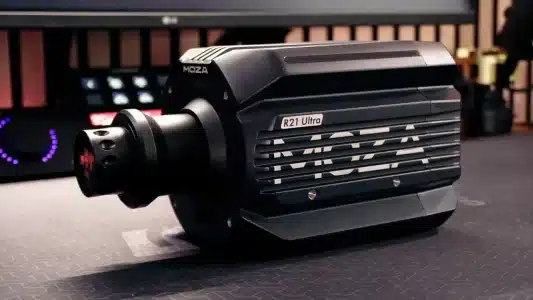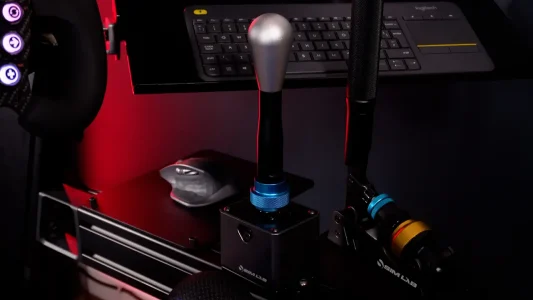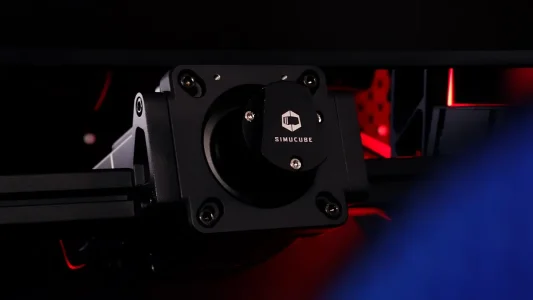
Our Verdict
Pros
- Excellent design
- Ergonomics are almost perfect
- Great compatibility with third party wheels and software
- Incredibly customisable via RaceHub software
- Pre-designed displays are great for those not using SimHub
- All inputs feel great to interact with
- Extremely satisfying front encoders and joystick
- Well dampened shifters, with great resistance
Cons
- Only PC compatible.
- Glass Fibre doesn’t feel premium
- Assembly required
- Push buttons do wobble
- Shifter paddles can echo
- Screen can lag during some transitions
- Can become expensive when adding upgradable shifters
Since reviewing the Asetek Invicta Formula wheel four months ago, it has been one of my most used wheels. It really nailed the ergonomics, functionality and design. So when this Forte Formula Pro wheel released, coming in at almost exactly half the price of the Invicta, yet looking almost identical, I was initially bamboozled.
A few thoughts crossed my mind. What a silly move undercutting their own product. Asetek are never going to sell another Invicta wheel again. But then I delved into the specs, saw the comparison and differences between the two wheels, and got first hand experience of both wheels in action thanks to Asetek being darlings and sending both wheels out for review.


So, if you’re looking for a new formula-style steering wheel with a screen, should you just get an Asetek Forte Pro and call it a day? In this review, I’m going to answer that exact question.
Watch our Asetek Forte Pro Steering Wheel Review
Forte Formula Pro vs Invicta Formula Wheel comparison
I’m going to kick this review off by jumping in and seeing exactly what this wheel is, and how it differs from the Invicta version.
Starting with fundamentals, this is a 300mm (or 304mm with the larger handles) formula-style steering wheel. Asetek has borrowed the overall design of the wheel from the Invicta, changed out a lot of the materials to lower production cost, and removed all customisation.
You can still choose your handles, just like you could with the Invicta, and you have the same choice including regular, XL, suede and LMP style. Other than that, all parts of the Forte Pro wheel are predefined.

You get a combination of black and grey inputs, with two orange joysticks, although two additional black ones are included, if you want to go full stealth mode. All of these inputs are constructed from aluminium, and are a match to those on the Invicta wheel, meaning they feel and perform exactly the same.
The layout of all inputs also matches the Invicta, making the two wheels look eerily similar. There are bigger changes on the rear, with the biggest being the shifters. You only get two plastic shifters included compared to the array of six carbon fibre paddles on the Invicta wheel. Although, it’s worth noting, you can upgrade to six paddles if you wanted.
The two buttons at the top of the wheel have been removed, and the quick release is also different. On the Forte Pro wheel it’s constructed from the same glass fiber material that is used on the entirety of the wheel.
This textured material is lightweight, giving the Forte Pro a distinctly light feeling compared to the much heavier Invicta. It is textured with a forged carbon fibre finish, and I have to say, while it is rigid, it definitely doesn’t feel premium. Although how much you’ll actually notice this while racing, we’re going to find out.


The screen nestled into the front of the wheel is again, the exact same 4.3inch 800×480 pixel touchscreen found in the Invicta wheel.
Price of the Asetek Forte Formula Pro Wheel
So, similarities and differences aside, how much does this Asetek Forte Formula Pro wheel cost? Well, the good news is that it will set you back €630 or $649 before sales tax. That price doesn’t include a set of handles which will set you back around €70/$70 give or take.
As I mentioned at the start of this review, this is pretty much half the price of the Invicta wheel. The Invicta costs €/$1,250, again without handles included.
| Product | Price |
|---|---|
| Asetek Forte Pro Formula Wheel | EU: €630 US: $649 |
| Asetek Invicta Formula Wheel | EU: €1250 US: $1250 |
What is the competition?
What else is there around from other brands? Well, Fanatec still amazingly doesn’t have a single wheel with a screen in this price range. MOZA has the FSR2, which is priced very similarly to the Forte Pro. Personally, the Forte Pro looks and feels more premium than the FSR2.
Thrustmaster has its SF1000, which looks stunning from a distance, but feels rather cheap up close. Then you have brands such as Cube Controls, Ascher Racing, GSI etc. But to get something with a screen, you’re looking at over €/$1,000.
That puts this wheel in a bit of a unique spot. It’s a premium wheel in its design, inputs and functionality, without the mega hefty price tag that most premium wheels command.
Unboxing and what’s included
When you first open the newly designed box, you’ll get hit with a batch of paper from warranty info, to safety information. Then, you get the sticker sheets, of which there are quite a few. There are Asetek stickers to put anywhere you fancy. LED stickers to cover the LED lights above the inputs, and stickers to wrap around the rotary encoders.
Inside the foam, you get the wheel itself which comes in three parts. The wheel hub, and two separately enclosed shifter paddles. This, along with the lack of handles in this box means some assembly is required, which again differentiates this from the Invicta wheel which is hand-built at the Asetek factory, and delivered, ready to race.
You do get all of the tools required to build the wheel, and even some little pincers to put the stickers on with.

Assembly
If you do buy handles with the Pro wheel, something, you’re very much going to need to use it. They’ll arrive in a separate box simply adding to the assembly job we need to undertake before we start racing.
The process of assembling the wheel is pretty straight forward. I’ve build enough sim rigs and wheels to be able to stumble through this installation. Inside the little bag, you’ll find the rubber separators that need to go over the handles.
Then, it’s a case of bolting on the hand grips using the included screws. Before attaching the shifter paddles. This is slightly trickier due to the magnets on the rear of the shifters, which always want to pull your Allen key away from its position. But with a little patience, all comes together in a few quick minutes.
I don’t really mind the installation process. There is enough customisation and assembly required with other sim racing wheels and hardware, that it’s second nature these days. But it does take a little away from the premium feel that wheels like the Invicta have.
The design and performance of the Asetek Forte Formula Pro Wheel
Once fully built, this wheel looks rather stunning. Asetek has lifted the majority of the design from the stunning Invicta wheel, meaning this Forte Pro wheel has incredibly good fundamentals to work from.
The real point of difference here is the glass fibre construction. This doesn’t detract too much from the wheel in its appearance. It certainly doesn’t look as premium as the Invicta or a true carbon fibre face plate. But the biggest difference comes in how it feels.

It has a soft touch, almost plastic feel to it, with a textured, rather scratchy finish. We’ve seen this style of finish before on wheels from MOZA and SIMAGIC, and I don’t hate it. As I mentioned, it takes almost nothing away from the gameplay and performance, and for me that is what matters most.
As a whole, this wheel replicates a real-world formula wheel closely. You have the large screen in the center, surrounded by easy to reach buttons and inputs. Across the front in the center are the three encoders, with another six encoders positioned around the edges of the wheel.
Push buttons
All inputs are constructed from aluminium, and feel nice to interact with. With these being the same as the inputs on the Invicta wheel, the button wobble that plagued the Invicta returns here, but so does the positive click with each button press.
Small design decisions such as the different height button shrouding are tiny details that make a big difference in the heat of a race. Finding the button you need to cycle the wipers or talk to your engineer is incredibly intuitive as you can feel that subtle difference between each button.

Encoders
Continuing the excellent inputs are the encoders. All of these metal encoders look stunning in their black colourway, and they each have a stiffer than average activation. The three front facing encoders in particular are on the stiffer side, and this helps with precision when changing engine mode or battery deployment. Each rotation falls into place nicely, and there is zero chance of accidentally rotating these encoders too far.
The thumb encoders that are set into the wheel feel looser and easier to interact with. And this helps make quick brake bias or TC adjustments on the fly with little effort. My only real criticism of these encoders is the top thumb encoder being mounted horizontally. I much prefer vertically mounted thumb encoders as they just feel a little more natural, but this is entirely personal preference.

Joysticks
Nestled between the thumb and front facing encoders are two brightly coloured orange joysticks. These are again constructed from aluminium, and there are two black caps included if you don’t like the orange.
For a sim racing wheel, these inputs are essential for navigating menus and your black box or MFD. Out of all the inputs on the wheel, these feel the nicest thanks to the really satisfying notchiness that they both have when rotated. They also click and have directional inputs, making them incredibly versatile.
Two slightly less versatile inputs are the two toggle switches found at the top of the wheel. These both have two actions available and the extra configurable inputs is always a welcome addition on any wheel. Much like my Invicta review, I think these look a little unfinished in the bare silver metal, and I would have preferred a rubber cap to finish them off.

Shifters
Flipping this wheel over, we have just two lonely shifter paddles. These are Asetek’s standard paddles that can be found on a variety of wheels and button boxes. They are constructed from plastic and designed with a small lip for pretty good ergonomics.
Each shift feels on the stiffer side, and I’ve always liked how Asetek shifters feel. These are magnetic contactless shifters which is pretty much the gold standard in terms of longevity and durability. And while the resistance is pretty strong, each shift itself is short and well dampened. There is a slight echo as you pull a shift, but they certainly aren’t the loudest I’ve come across.
Quick release
The QR itself is constructed from the same glass composite that the rest of the wheel uses, and this makes it feel light, but this thing is extremely rock solid. There is zero flex at all from this thing when mounted to your wheel base. And mounting this wheel is incredibly easy thanks to Asetek’s patented QR design, which is among the best in the business.
Ergonomics and hand grips
The beauty of this wheel, and pretty much any Asetek wheel is the mix and match hand grips. You can opt for rubber or suede, and from a formula or LMP design. I’ve gone for the XL formula handles in rubber, and these are some girthy boys.
Each grip is moulded to allow your hand to wrap naturally around it, with grooves for your thumbs natural position. On the rear are grooves for each finger, and overall these are some of the comfiest hand grips to race with. The extra chunk that these XL grips introduce, make the wheel feel really solid in your hand. And I might end up transferring these grips onto my Invicta wheel, they’re just that nice.
Display
Rounding out the design of this wheel is the 4.3 inch touchscreen on the front. This is an 800×480 pixel LCD display that runs at 60Hz ensuring for crisp and fast data readouts.
The whole display and all rev and flag lights are situated behind a single piece of glass which makes the display feel bigger than it is. Asetek have also gone above and beyond with their RaceHub software and made all animations and display elements look incredible.

Software
And that leads me nicely onto the software part of this review. Asetek entered the sim racing space a good few years ago, and since the start, their intentions have been clear, to become one of the very best sim racing brands around.
They started strong offering a complete racing wheel and pedal ecosystem from day 1, and have lifted a lot from the best brands around such as Simucube. I have to say, this mentality continues through to every part of the brand, with their software being one of the best of any brand.
RaceHub isn’t just a place to update firmware. You can change how the wheel behaves in every area, from the colour, direction and behaviour of the rev and flag lights. To changing the colour of each button LED, and how it handles inputs, such as staying latched on or off.

With the display, you get a lot of customisation. You can choose to run the entire display and wheel through SimHub, opening up almost endless customisation. Or you can choose one of Asetek’s own dash designs which include Formula, GT and Road Car layouts. Each of these includes key information, with touch areas to cycle through various info.
Other brands are catching up with their software, with the new Fanatec app, and Simucube’s Tuner software having big improvements. However, currently, I’d say Asetek is still one of the leaders in this area of sim racing.
Should you just buy a Forte Pro instead of an Invicta?
So, that brings me to my final thoughts. There is no doubt that this is an incredibly capable sim racing wheel. It borrows the incredible design and inputs from the big daddy Invicta wheel, which instantly makes this Forte Pro shine.
Asetek has cut the cost of the Invicta roughly in half due to some smart omissions and changes. The glass fibre is a big part of this, as is the removal of the extra rear paddles and buttons. Both of these decisions don’t grate on me hugely, with the glass fibre looking nice, and rarely being interacted with. And if you need some extra paddles for a dual clutch, the option to add them as an upgrade in the future is there for you.

Really, I feel that Asetek has gone ahead and undercut their own Invicta wheel by releasing this Forte Pro. It’s a strange business decision, as this wheel is a much more attractive proposition than the Invicta, and I would bet a lot of money that they’ll sell a hell of a lot more of these than they will the Invicta.
In a snapshot, I couldn’t recommend this Forte Pro enough. It sits in a unique price range bridging mid-range and premium, and is the obvious choice for sim racers looking to upgrade from a budget wheel or one without a screen.
Frequently asked questions
Technical Specifications
Review written by Felix König













